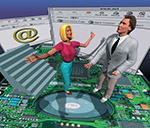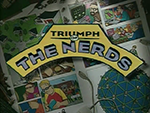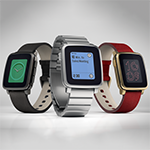 We didn’t have wifi. We didn’t even have broadband. We just had dial-up. And even that required hoping that an Internet Service Provider had a local dial-up phone number. Otherwise, it was a long-distance call using your landline. Even America Online, the most popular online service at the time, didn’t have Internet access. Because how could they? The web browser had just been invented. And other than the web browser, there wasn’t really any great reason to access the Internet. Except maybe e-mail. But since nobody had Internet, that meant nobody had an Internet email address. In the beginning, we didn’t really have any Internet apps, just protocols for hypothetical apps. I remember discovering the Internet when it was “new”, back in the early 1990’s. Yeah, the Internet itself existed for decades before then. But lets just agree that the modern Internet, when it became popular for mainstream use, was “new” in the early 90’s. Here’s what I remember about my first dial-up internet account and Internet apps we used twenty-five years ago. Trumpet Winsock. NCSA Mosaic. Eudora Email. Usenet. IRC. FTP. This is what the Internet was like back in the day.
We didn’t have wifi. We didn’t even have broadband. We just had dial-up. And even that required hoping that an Internet Service Provider had a local dial-up phone number. Otherwise, it was a long-distance call using your landline. Even America Online, the most popular online service at the time, didn’t have Internet access. Because how could they? The web browser had just been invented. And other than the web browser, there wasn’t really any great reason to access the Internet. Except maybe e-mail. But since nobody had Internet, that meant nobody had an Internet email address. In the beginning, we didn’t really have any Internet apps, just protocols for hypothetical apps. I remember discovering the Internet when it was “new”, back in the early 1990’s. Yeah, the Internet itself existed for decades before then. But lets just agree that the modern Internet, when it became popular for mainstream use, was “new” in the early 90’s. Here’s what I remember about my first dial-up internet account and Internet apps we used twenty-five years ago. Trumpet Winsock. NCSA Mosaic. Eudora Email. Usenet. IRC. FTP. This is what the Internet was like back in the day.
Local ISP’s
Internet access in the early ’90s was an almost clandestine thing. Local Internet Service Providers (ISP’s), often with just one office location, bought dedicated access to the Internet through a telecom provider. They would then also lease a bank of phone lines that could be dialed into using one phone number. When a user would dial-in, one in a pool of modems that was connected to a computer would authenticate the user and connect them up to the ISP’s dedicated Internet access. This rather straightforward way to create your own ISP resulted in an ever-increasing number of small local ISP’s through the mid-1990’s. As the Internet got popular, monthly subscription fees for dial-up access added up quickly. And as prices decreased for dedicated Internet access, running a local ISP also got more profitable. This lead to industry consolidation in the very late ’90s, as all those small ISP’s were bought up by bigger companies looking to form major national ISP’s. By the early years of the new millenium, the era of small local ISP’s was gone.
Dial-Up Internet
One Saturday in 1994, like many people, I was making my weekend visit to the local computer stores, including Microcenter, which had just opened a year earlier, at its original Houston location at San Felipe and 610. A local ISP had a little kiosk setup in the store with two guys standing there like missionaries, with little pamphlets explaining the Internet and trying to get people to sign-up for a dial-up account. My recollection was that I asked them why I needed this Internet thing when I could already dial into bulletin boards. They explained to me that this was like dialing into thousands of bulletin boards at once, which sounded cool. And you could run programs that accessed the Internet in different ways, unlike bulletin boards that were basically text-only and accessed through a terminal application. One program they said that was getting popular was a “browser for the world-wide web”, which honestly made almost no sense to me. And you could run an electronic mail program, which I had heard of before. The ISP reps also said there were message boards, called “Usenet“, which I guess sounded interesting. And Internet Relay Chat, a way to chat with people in real-time. There was also utilities like Archie, Veronica, WAIS, and Gopher. I didn’t know what I would use any of that for, but whatever.
But the thing that sold me on getting a dial-up Internet account was actually FTP, the File Transfer Protocol. Before there were web servers (“www.”), there were just file servers (“ftp.”). I liked downloading apps and games on bulletin boards, because that made my computer useful. The problem with bulletin boards (BBS’s) is that somebody must upload the file you want to that specific BBS before anybody else can download it. Another problem with BBS’s is that a BBS can only have so many people connected at a time as that BBS has phone lines. So most BBS’s can only have one, or a few, connected users at a time, and you gotta wait for somebody else to log-off before you can dial-in. The ISP representatives at the Microcenter explained to me that FTP was as simple as using a free FTP app. That gave you the ability to connect to file servers whenever you wanted, and until you found whatever file you wanted. Well worth twenty bucks a month. I filled out the form to sign-up and they said my account would be active by that evening. They gave me several 1.44 MB floppy disks with all the apps I would need to access the Internet and some printed papers stapled together explaining how to install everything.
Trumpet Winsock
Microsoft Windows didn’t have built-in support for dial-up networking until Windows 95. And this was 1994. So dial-up meant using a program called Trumpet Winsock. It was an all-in-one dialer (that uses the modem to dial the phone), Point-to-Point Protocol to connect to the dial-up server, and 16-bit TCP/IP stack. TCP/IP, for those that don’t know, is the packet-switching and routing protocol that makes the Internet possible. It’s the “Transmission Control Protocol / Internet Protocol”. Every app that uses the Internet necessarily uses TCP/IP.
NCSA Mosaic Web Browser
Some of you are so young that you will always take the web browser for granted. There was a time when you had to either download a web browser or go to a software store and buy it. Yes, there was a time when people physically went to a software store and actually paid money just to get a box that had a floppy disk, or possibly a CD, that included a web browser that you could install. NCSA Mosaic was the name of Netscape Navigator (the original mainstream web browser) before it’s developer, Eric Bina, and some other guy decided to try and make a business out of selling it. I was on the Internet before there was a Netscape. Then there was the Browser Wars. Now we take the web browser for granted. It is interesting to me that the browser itself is still basically the same as it was twenty-five years ago. The web browser is still just a window on your computer with an address bar and bookmarks.
Eudora Email
Eudora was the most popular email program for Windows back in the day. Long after there were better alternatives, I still saw people using Eudora. Inasmuch as Windows didn’t have dial-up networking until Windows 95, it also didn’t have an Internet email program. We also didn’t yet have webmail, which is a website to access your email like Hotmail, Yahoo! Mail, or Gmail. This was an innocent time before bulk email, so using email was actually kind of exciting. You could configure your email program to play a sound when you got an email, since the only email you got was email that you wanted. Somebody on the other side of the planet could send you an electronic message that arrived within seconds. In the early 1990’s, such things impressed us.
Usenet
Usenet is Internet-wide message boards, officially called newsgroups, and uses the Network News Transfer Protocol (NNTP). You access Usenet through a newsgroup reader. At first, I used Forté Free Agent, which was the only decent newsgroup reader available for Windows. In 1996, I switched to Outlook Express for email and newsgroups because it was included with Internet Explorer 3.0. Back before the Internet got so mainstream that everybody was on the Internet, you could actually have real discussions with smart interesting people on Usenet.
Usenet was also a way to trade files, mostly through the alt.binaries.* newsgroups. For example, there was alt.binaries.games to download games and alt.binaries.mp3 for MP3 files (after mp3 became popular). Files could be converted to plain text in a format known as uuencoding . Once a file was uunencoded, you could copy/paste it into a message and post it on the newsgroup message board. Then a newsgroup reader with support for uudecoding could convert it back to the original game or mp3.
When I was fifteen, I met one of my best friends my own age, and that also lived in Houston, through Usenet. We would’ve never met each other otherwise.
IRC
Internet Relay Chat is real-time chat for everybody on the Internet. Other online services obviously had chat rooms back in the day. What made IRC cool and different in the early 90’s was that you were chatting with other people on the Internet, which was still only for smart people. And because the Internet was small enough, there was usually only one chat room (called a “channel” in IRC-speak) for a given topic. So for example, if you wanted to learn a programming language, you could go to the channel for that programming language, and you were instantly in a room with everybody of every skill level for that programming language. Even if you didn’t actually chat, you could just sit there and read all the chat room messages between everybody else as they scrolled up your screen and from that learn to program (or whatever the topic for that chat room).
The proper way to use IRC was to connect to your favorite IRC server, open up all your favorite IRC channels at once, and then shut out the rest of the world. The reason is that communicating offline with one person requires giving that one person all your undivided attention, whereas on IRC you can just sit there and chat with literally hundreds of people all at once for days at a time. On IRC, nobody cares what you are wearing (if anything), what you look like, or even what you smell like.
mIRC was, and is, effectively the de facto standard IRC app for Windows. Those 1.44 MB floppy disks I got in 1994 with my dial-up account came with a janky “WSIRC” program. But I quickly discovered mIRC when it was originally released in 1995. It supports every damn feature you could want on IRC: colored text, a list of everybody in the chat room, a separate window for each chat room so you could be in multiple channels at once, and direct client-to-client file transfers (DCC). DCC made it possible to just ask for a file in a chatroom and somebody could DCC it to you instantly, a big deal in those days. mIRC is used by millions of people all over the world, and yet now almost twenty-five years later is still written by just one guy, Khaled Mardam-Bey, who over the years has added all sorts of new features like its own scripting language and even made mIRC Turing complete.
We Downloaded Files Because We Didn’t Have Websites Or Even PDF
Writing this post it occurs to me that downloading files has been a recurring theme. You gotta remember that in the early 1990’s the web browser was new. Hence, there weren’t many websites and most of them weren’t very good. There were so few quality websites that you could fit them all in a single directory, which is how Yahoo! got started. Before there was websites, you could download text files and you could download pictures. At best, you had maybe a Microsoft Word document with some embedded Screen Beans clipart. Even PDF didn’t much exist. PDF was originally released in 1993 and invented by a company named Adobe. PDF was considered a proprietary format until 2008. Until then, the only legit way to make PDF files was if you paid Adobe for the Adobe Acrobat software that made PDF’s. So with no websites or PDF, finding ways to separately download files like text files and pictures was all we had.
Twenty-Five Years Later
When you’re young, older people sometimes say things like “We didn’t have that when I was your age.” And when you’re young, you’re like “Whatever, Gramps.” But then you get older and you’re like “We didn’t have that when I was your age.” And the young people are all like “Whatever, Gramps.” That’s the whole cycle of life, I guess. But in twenty-five years on the Internet, not much has really changed. Dial-up low-speed Internet has certainly been replaced with free, or almost free, broadband wi-fi that you can connect to almost anywhere with any computer or smartphone. All the apps and protocols I’ve mention are still around and still being used. The world wide web and electronic mail haven’t really changed at all, although there is much more of both. Usenet and IRC still exist, but I guess the Internet got so big and mainstream that perhaps those protocols and apps aren’t as edgy and interesting as they once were. Anyway, that’s what being on the Internet was like twenty-five years ago when it was new, back in the day.
 Triumph of the Nerds: The Personal Computer
Triumph of the Nerds: The Personal Computer
 Prizeo Brings Together Celebrities And Charities To Increase Awareness And Raise Money
Prizeo Brings Together Celebrities And Charities To Increase Awareness And Raise Money
 Venture Deals Explains Modern Venture Capital
Venture Deals Explains Modern Venture Capital
 Five Years of Y Combinator Universe
Five Years of Y Combinator Universe






